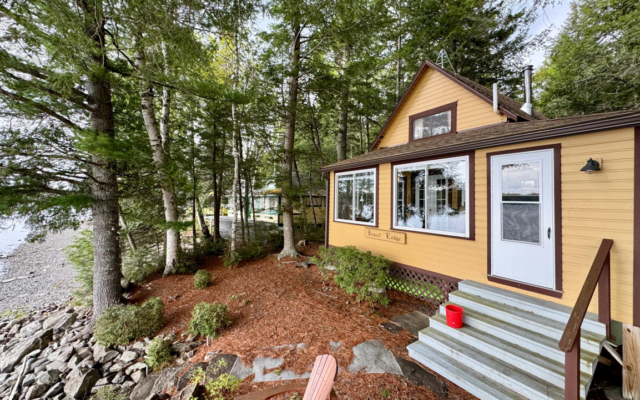
Camps on Maine’s rural lakes are seeing historic levels of interest
By Zara Norman, Bangor Daily News Staff
It used to be easy to find a camp in rural Maine. After nearly 50 years in real estate, Patsy Mallett can count on one hand how many times she’s seen a shortage of listings on Sebec Lake near Dover-Foxcroft.
This year is one of those times.
“There’s a shortage of listings on the lake, more so this time than it has been in the past,” Mallett, an associate broker with Mallett Real Estate, said. “The ones we put up go pretty fast.”
Buyers looking at lakefront camps in Maine used to be able to get good deals in rural areas, but real estate agents like Mallett say that is happening much less in today’s crazy real estate market. Skyrocketing prices in southern areas have sent prospective buyers north, sending prices soaring and squeezing some buyers out.

LAKEFRONT CAMP — A seasonal camp on Sebec Lake at 16 Eider Lane in Dover-Foxcroft. Lakefront camps for sale in rural regions are seeing record demand this year.
In Piscataquis County, where Mallett Real Estate operates, the average home sales price has skyrocketed from $227,000 in March 2020 to $382,000 at that time in 2024, according to data from Maine’s Multiple Listing Service. That’s a 68 percent increase in four years, and reflects a surge in demand for little inventory.
Some listings in town, Mallett said, aren’t even making it to the market before they’re under contract and most are under within two weeks. One of her only listings, on Eider Lane, is a summer cottage listed for $475,000. The average family in the area can only afford a home up to around $246,000, according to Zillow’s affordability calculator.
Other rural regions report a similar situation. Before the COVID-19 pandemic, it wasn’t too difficult for the average Maine family to buy a lakefront camp in Millinocket, Dan Corcoran, designated broker-owner of North Woods Real Estate, said.
The mill town was something of a “hidden gem” despite its proximity to Mount Katahdin and Baxter State Park, Corcoran said. The market is very different now.
“Since COVID started, we’ve seen a dramatic increase in demand and that’s pushed up prices in our area,” Corcoran said. “Our prices are still competitive compared to southern Maine, but we’ve seen a jump. I think they’re still affordable to middle-class folks.”
Very few lakefront properties are on the market in Millinocket, Corcoran said. Much like Mallett, the two lakefront properties listed by his firm this season were under contract within weeks, he said.
Some real estate agents, like Corcoran, think that the driver behind this increased demand for more rural lakefront camps originates in southern Maine. There, a pronounced increase in prices has priced some buyers out, pushing them to search northward.
“People want Sebago, but a lot of times they can’t afford it anymore, because it’s all in the millions.” Lois O’Connor, Casco-based broker-owner of Sunset Lakes Real Estate, said. “If they can’t find what they want here, they move north.”
Very few homes and even plots of land are available for purchase in southern Maine right now, O’Connor said. The ones that are on the market far outpace what the typical family could afford.
There’s a glimmer of hope on the horizon, though. O’Connor feels the southern Maine property market is cooling from the fever pitch. Properties are sitting on the market for longer. She’s even trying to convince some of her Sebago Lake buyers to lower their asking price.
“A lot of sellers have that COVID price on their mind, but this market is switching,” O’Connor said. “The properties have really gotten so expensive that it’s basically all out-of-staters flying in.”
With luck, if it’s high demand and low inventory in southern Maine that’s pushed prices up, the effects of a cooler market down south might eventually be felt up here, too. But agents predict it will still be a summer of record demand.
“Our housing market has seen a sharp jump and we expect that demand is going to increase,” Corcoran said.